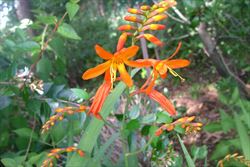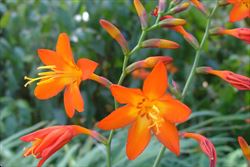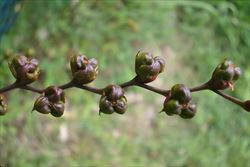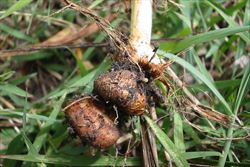Click on images to enlarge

infestation (Photo: Sheldon Navie)

habit (Photo: Sheldon Navie)

habit (Photo: Sheldon Navie)

strap-like leaves (Photo: Sheldon Navie)

branched flower cluster (Photo: Sheldon Navie)

flowers (Photo: Sheldon Navie)

close-up of flower (Photo: Sheldon Navie)

immature fruit (Photo: Sheldon Navie)

close-up of mature fruit (Photo: Sheldon Navie)

yellow-flowered garden cultivar (Photo: Sheldon Navie)

'bulbs' (Photo: Sheldon Navie)
Scientific Name
Crocosmia x crocosmiiflora (Lem.) N.E. Brown
Synonyms
Crocosmia aurea (Pappe ex Hook.) Planch. (misapplied)Crocosmia aurea (Pappe ex Hook.) Planch. x Crocosmia pottsii (McNab ex Baker) N.E. BrownCrocosmia crocosmiiflora (Lem.) N.E. BrownMontbretia x crocosmaeflora Lem.Montbretia x crocosmiaeflora MorrenMontbretia x crocosmiiflora Lem.Tritonia crocosmaeflora Lem.Tritonia crocosmiiflora Nichols.Tritonia x crocosmiflora (Lem.) NicholsTritonia x crocosmiiflora Nichols.
Family
Iridaceae
Common Names
common montbretia, crocosmia, garden montbretia, montbretia
Origin
This plant is a hybrid of horticultural origin and is derived from Crocosmia aurea and Crocosmia pottsii. Both of these species originated in southern Africa, and the horticultural hybrid was developed in France.
Cultivation
Many cultivars of this hybrid are still common in cultivation in southern and eastern Australia.
Naturalised Distribution
This species has a relatively widespread, but scattered, distribution in the coastal regions of south-eastern Australia. It is most common near heavily populated areas in eastern New South Wales, southern Victoria, south-eastern South Australia, south-western Western Australia, Tasmania and south-eastern Queensland. It is also naturalised in other parts of these states and on Lord Howe Island.
Habitat
A weed of temperate and sub-tropical environments. It inhabits wetter grasslands, open woodlands, pastures, waterways, gardens, roadsides, waste areas, disturbed sites and railway enclosures.
Habit
An upright (i.e. erect), long-lived (i.e. perennial), herbaceous plant usually growing to about 60 cm tall, but sometimes reaching up to 100 cm in height. The aboveground foliage is short-lived, and grows back each year from underground 'bulbs' (i.e. corms) and creeping stems (i.e. rhizomes).
Distinguishing Features
- an upright herbaceous plant (up to 60 cm tall) with short-lived foliage that grows each year from long-lived underground 'bulbs'.
- its 'bulbs' (10-35 mm across) are rounded or flattened and covered in several brown fibrous layers.
- its strap-like leaves (30-80 cm long and 1-2 cm wide) are mostly clustered near the base of the plant and sheath the stem.
- its flowers (3-4 cm long and 2-5 cm wide) are borne in elongated clusters at the top of the stems.
- these yellow to orange-red flowers are tubular in shape and have six 'petals'.
- its three-lobed capsules (5-10 mm long) turn brown and become shrivelled as they mature.
Stems and Leaves
The green stems are rounded, upright (i.e. erect) or loosely arching, and usually have a few branches near their tips (on which the flowers are borne).
The leaves (30-80 cm long and 1-2 cm wide) are mostly clustered near the base of the plant. There are usually only about 6-12 leaves produced by each individual 'bulb' (i.e. corm) and they sheath the stem at their bases. These leaves are strap-like (i.e. lanceolate or ensiform), soft, and sometime droop towards the ground. They are hairless (i.e. glabrous) with entire margins and pointed tips (i.e. acute apices).
Flowers and Fruit
The tubular flowers (3-4 cm long and 2-5 cm wide) are borne in two rows along the zig-zagging branches at the top of the stems. Each branch is 15-30 cm long and has 4-20 flowers. The flowers are yellow to orange-red (usually orange-red with yellow centres) in colour with six 'petals' (i.e. perianth segments or tepals) that are fused together at the base into a tube (i.e. perianth tube) 12-18 mm long. They also have three stamens and a style that splits into three short branches (about 4 mm long) near its tip, each topped with a stigma. Flowering occurs mostly during summer and autumn, but also during spring in warmer climates.
The fruit are three-lobed capsules (5-10 mm long) that turn from green to brown, and become shrivelled, as they mature. Seeds are usually not produced, but when present they are brown or reddish-brown in colour and flattened or triangular in shape (about 3 mm long and 1-2 mm wide).
Reproduction and Dispersal
New plants develop from the tips of the creeping underground stems (i.e. rhizomes), which are produced by the 'bulbs' (i.e. corms) and grow up to 30 cm long. The 'bulbs' (10-35 mm across) are rounded or flattened (i.e. globose or compressed) and covered in several brown fibrous layers.
Infestations spread laterally via the growth of underground rhizomes while long-range dispersal of the corms and seeds occurs via water, machinery, contaminated soil or dumped garden waste.
Environmental Impact
Montbretia (Crocosmia x crocosmiiflora ) is regarded as a significant environmental weed in Victoria and New South Wales, and a moderately important environmental weed in Queensland, Western Australia and Tasmania. In 2006, this species was listed as a priority environmental weed in two Natural Resource Management regions.
It is invasive in moist forests, roadside remnants, drainage lines and along waterways in the coastal districts of southern Australia. It competes strongly with, and displaces, native riparian plants and moves rapidly along watercourses and outwards into sensitive bushland. Dense infestations crowd out the native ground flora and impede the regeneration of overstorey species, and can also significantly modify the habitat available to native animals.
Other Impacts
The dense layer of 'bulbs' (i.e. corms) in the upper soil layer can contribute to the erosion of creek banks and the siltation of waterways.
Legislation
This species is declared under legislation in the following states and territories:
- New South Wales: Class 4 - a locally controlled weed. The growth and spread of this species must be controlled according to the measures specified in a management plan published by the local control authority and the plant may not be sold, propagated or knowingly distributed (in the Blue Mountains local authority area only).
- Western Australia: Unassessed - this species is declared in other states or territories and is prohibited until assessed via a weed risk assessment (throughout the entire state).
Management
For information on the management of this species see the following resources:
- the New South Wales Department of Primary Industries Noxious and Environmental Weed Control Handbook, which can be downloaded from http://www.dpi.nsw.gov.au.
- Muyt (2001), Bush Invaders of South-east Australia, pp. 88-89.
Similar Species
Montbretia (Crocosmia x crocosmiiflora) is similar to African cornflag (Chasmanthe floribunda) and bulbil watsonia (Watsonia meriana var. bulbillifera). These species can be distinguished by the following differences:
- montbretia (Crocosmia x crocosmiiflora) is a relatively small plant (usually less than 60 cm tall) with relatively small leaves (30-80 cm long) that are rarely more than 20 mm across. Its flowers have three stigmas and they are arranged along the branches in a slightly zig-zagging pattern.
- African cornflag (Chasmanthe floribunda) is a relatively large plant (usually about 1.5 m tall) with relatively large leaves (more than 80 cm long) that are usually 20-40 mm across. Its flowers have three stigmas and the uppermost 'petal lobe' is significantly longer than the others.
- bulbil watsonia (Watsonia meriana var. bulbillifera ) is a relatively large plant (usually 1-1.8 m tall) with relatively large leaves (50-80 cm long) that are usually 20-50 mm across. Its flowers have six stigmas and it rarely produces fruit (instead it produces clumps of cormils or bulbils on the upper stem joints).

